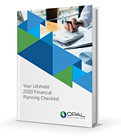5 Effective Retirement Income Strategies for a Volatile Market
By Jesse Giordano, CFP® | August 24, 2022We understand that market volatility can be difficult to stomach, especially if you’re heading into retirement or are already out of the workforce. After decades of saving, retirement is about stepping back from the grind and comfortably living off your nest egg. Having a retirement income strategy is critical.
Designing a portfolio to see you through retirement is different from the way we invest during our working years. The goal is to ensure that your monthly income will always be there—no matter what’s going on in the markets. Proper planning is the best way to do just that. Let’s unpack some key strategies for building a retirement income portfolio that can go the distance.

Why Your Portfolio Structure Matters
Before we dig into specific strategies, let’s first lean into so-called set-it-and-forget-it retirement saving models. The draw is that they automatically rebalance themselves to align with your target retirement date. They may work well during accumulation years (when you’re earning income), but where’s the cash flow plan during retirement distribution years? Without it, you run the very real risk of outliving your money.
A strong retirement portfolio is one that can provide predictable cash flow when you’re no longer working, so you’ll want to select investments wisely. A high stock allocation that rebalances periodically may not be appropriate if you’re relying on your portfolio to supplement your retirement income.
The 2000 to 2002 market correction is a good example. The bursting of the dot-com bubble, the 9/11 attacks, and the failure of Enron and WorldCom led the S&P 500 to decline by over 40%. While the market fully recovered just a few years later, a retiree who planned on taking 5% of their savings during each of those down years would have seen their portfolio’s value shrink by 55%. It’s unlikely that such a decline would have recovered since additional withdrawals would need to have been taken in subsequent years.
5 Effective Retirement Income Portfolio Strategies
1. Plan with Cash Flow in Mind
Investing in a diversified set of companies with stable and growing earnings usually makes sense for pre and current retirees. If the dividends are sufficient, they can provide insulation against market volatility. However, if the dividend rate is below your needs, you could be forced to sell a portion of your stock at depressed levels.
The question then turns to how to choose dividend-paying stocks. As interest rates rise, hone in on well-established companies that are known for dividend growth. Just keep in mind that it’s possible for stock prices to fall while earnings increase. Let’s look at Verizon as an example. In 2006, the company’s total cash flow from continuing operations was $23 billion. Verizon continued to grow their cash flow from business operations each year until 2011. They went on to increase their dividend from $1.67 per share to $1.97. Despite the 2008 financial crisis when the global banking system nearly collapsed, Verizon continued to grow cash flow and their dividends all the way through that period.
You’d think the stock price would have continued to grow in kind. It actually lost 40% of its value through the financial crisis before fully recovering four years later. After that, they went on to double their pre-financial crisis value by 2014, despite the 2008 decline.
Verizon may be a great example, but dividend-paying stocks are not the only solution. Investors might also want to include bonds, master limited partnerships (MLPs), closed-end funds, and alternative investments like real estate and alternative income vehicles that have attractive risk-adjusted income.
2. Understand the Retirement Bucket Strategy
This strategy sorts your retirement income into three “buckets.”
- Short-term: Liquid investments go here and can include cash, high-yield savings accounts, short-term CDs and more. The goal is to hold two years’ worth of expenses in this bucket. When market volatility rears its ugly head, you won’t be as affected because your day-to-day expenses are already covered.
- Intermediate: This bucket is earmarked for expenses that crop up three to 10 years after retiring. Investments here should be aimed at keeping up with inflation, but not so risky that they threaten your overarching portfolio. They may include assets like long-term CDs and bonds, as well as real estate investment trusts (REITs).
- Long-term: Your riskiest investments go here. This bucket might be impacted by short-term market volatility, but investments will ideally rebound and grow over the next decade and beyond. It will likely include a healthy mix of stocks.
3. Consider a Retirement Anchor Portfolio
This approach might work well for someone who prefers a large allocation of stocks throughout retirement. It essentially creates an anchor portfolio that contains three years’ worth of spending money. It goes like this: the retiree takes their income from a 60/40 stock-to-bond portfolio while markets are normal. But when markets drop 20% or more, withdrawals are switched to the anchor portfolio, which is invested conservatively in bonds, CDs and cash. Think of it almost like an emergency fund.
The 2008 financial crisis would have delivered a -36% return for a 60/40 portfolio, which would have taken almost three years to recover. Having an anchor portfolio in the background can help protect retirees from such scenarios.
4. Explore Annuities
Annuities have gotten a bad name for their notoriously high fee structures, but the lifetime income benefits they provide may be worth considering—especially if you want to try to guarantee income for a portion of your retirement. You purchase an income annuity from an insurance company. After that, you’ll receive fixed payments that may provide a steady stream of guaranteed retirement income (usually for the rest of your life). What’s more, annuities typically allow for tax-deferred growth.
Fees can be a killer if you adjust the base plan, add any type of rider to the policy, or choose to surrender the contract. Pulling money out of an annuity can also trigger steep penalties and taxes. Discussing the pros and cons of annuities with a financial advisor is probably your best bet.
5. Spend Down and Replenish with Life Insurance
Another option is reducing your stock allocation, drawing on your investments and savings, and creating a legacy with applicable life insurance. If providing your children with an inheritance is an important goal for you, reducing your lifestyle to preserve your wealth isn’t the only answer. Instead of paring down your living expenses or trying to push your portfolio to grow by investing in a large percentage of stocks, you may be better off building a conservative investment portfolio and leaning more heavily on your life insurance policy for your legacy. When you pass away, your children will be provided with a tax-free life insurance benefit that they’ll receive without the possible complications of probate.
At Opal Wealth Advisors, we build retirement portfolios that help our clients navigate volatility so they can live the retirement they love. We begin by clarifying your retirement goals, then we create a plan to help achieve them despite volatility—and we’re with you every step of the way. Connect with us today to start planning for your future.
Be a Smart Investor
Stay up-to-date with industry-leading information and news delivered straight to your inbox.
Get our timely insights delivered to your inbox (Blog)
Please remember that past performance may not be indicative of future results. Different types of investments involve varying degrees of risk, and there can be no assurance that the future performance of any specific investment, investment strategy, or product (including the investments and/or investment strategies recommended or undertaken by Opal Wealth Advisors, LLC [“OWA]), or any non-investment related content, made reference to directly or indirectly in this commentary will be profitable, equal any corresponding indicated historical performance level(s), be suitable for your portfolio or individual situation, or prove successful. Due to various factors, including changing market conditions and/or applicable laws, the content may no longer be reflective of current opinions or positions. Moreover, you should not assume that any discussion or information contained in this commentary serves as the receipt of, or as a substitute for, personalized investment advice from OWA. OWA is neither a law firm, nor a certified public accounting firm, and no portion of the commentary content should be construed as legal or accounting advice. A copy of the OWA’s current written disclosure Brochure discussing our advisory services and fees continues to remain available upon request or at www.opalwealthadvisors.com. Please Remember: If you are a OWA client, please contact OWA, in writing, if there are any changes in your personal/financial situation or investment objectives for the purpose of reviewing/evaluating/revising our previous recommendations and/or services, or if you would like to impose, add, or to modify any reasonable restrictions to our investment advisory services. Unless, and until, you notify us, in writing, to the contrary, we shall continue to provide services as we do currently. Please Also Remember to advise us if you have not been receiving account statements (at least quarterly) from the account custodian.



